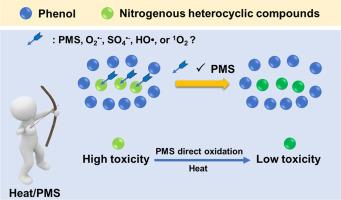当前位置:
X-MOL 学术
›
Water Res.
›
论文详情
Our official English website, www.x-mol.net, welcomes your
feedback! (Note: you will need to create a separate account there.)
Selective oxidation of nitrogenous heterocyclic compounds by heat/peroxymonosulfate in phenol-rich wastewater
Water Research ( IF 11.4 ) Pub Date : 2024-11-16 , DOI: 10.1016/j.watres.2024.122804 Liangjie Wang, Zhengyi Sun, Jinrui Shi, Han Li, Tao Fu, Yi Xu, Ke Xiao, Huazhang Zhao
Water Research ( IF 11.4 ) Pub Date : 2024-11-16 , DOI: 10.1016/j.watres.2024.122804 Liangjie Wang, Zhengyi Sun, Jinrui Shi, Han Li, Tao Fu, Yi Xu, Ke Xiao, Huazhang Zhao

|
In phenol-rich wastewater, such as coking wastewater, due to the high reactivity of phenol to various reactive oxygen species, it is difficult to selectively oxidize pollutants having lower biodegradability and higher toxicity than phenol. As one kind of such pollutants in coking wastewater, some nitrogenous heterocyclic compounds (NHCs) are more difficult to be removed by SO4•- or HO• than phenol, but this study found that NHCs (quinoline, isoquinoline, and pyridine) can be selectively removed by peroxymonosulfate (PMS) direct oxidation in the presence of 10 mM phenol under thermal condition. The selective oxidation of NHCs needs a suitable pH range (4 < constant pH < 9) because protonated state of NHCs (pH < 4) is unfavorable to their oxidation and high pH would improve the extra PMS consumption by phenol. Under the conditions benefiting the removal of NHCs in heat/PMS system, there was no generation of SO4•- and HO•. Being treated by 60 °C/PMS for 60 min, the biodegradability (BOD5/COD) of real coking wastewater (RCW) was improved from 0.21 to 0.44 with low removal rate of phenols (about 10%). Quinoline and indole, as the two typical NHCs in the studied RCW, their removal rates can be up to 45% and 85%, respectively. Thus, heat/PMS pretreatment is a potential good way to selectively remove high toxic pollutants in phenol-rich wastewater.
中文翻译:

富酚废水中热/过氧一硫酸盐对含氮杂环化合物的选择性氧化
在富含苯酚的废水中,如焦化废水中,由于苯酚对各种活性氧的高反应性,很难选择性氧化比苯酚生物降解性较低、毒性较高的污染物。作为焦化废水中的一类污染物,一些含氮杂环化合物 (NHC) 比苯酚更难被 SO4•- 或 HO• 去除,但本研究发现,在 10 mM 苯酚存在下,NHCs(喹啉、异喹啉和吡啶)可以通过过氧一硫酸盐 (PMS) 直接氧化选择性去除。NHCs的选择性氧化需要一个合适的pH范围(4 <恒定pH < 9),因为NHCs的质子化状态(pH < 4)不利于其氧化,而高pH值会提高苯酚对PMS的额外消耗。在有利于去除热/PMS 系统中 NHCs 的条件下,没有产生 SO4•- 和 HO•。经 60 °C/PMS 处理 60 min,炼焦废水 (RCW) 的生物降解性 (BOD5/COD) 从 0.21 提高到 0.44,酚类去除率较低(约 10%)。喹啉和吲哚作为所研究的 RCW 中的两种典型 NHC,它们的去除率分别可高达 45% 和 85%。因此,热/PMS 预处理是选择性去除富含苯酚的废水中的高毒污染物的潜在好方法。
更新日期:2024-11-16
中文翻译:

富酚废水中热/过氧一硫酸盐对含氮杂环化合物的选择性氧化
在富含苯酚的废水中,如焦化废水中,由于苯酚对各种活性氧的高反应性,很难选择性氧化比苯酚生物降解性较低、毒性较高的污染物。作为焦化废水中的一类污染物,一些含氮杂环化合物 (NHC) 比苯酚更难被 SO4•- 或 HO• 去除,但本研究发现,在 10 mM 苯酚存在下,NHCs(喹啉、异喹啉和吡啶)可以通过过氧一硫酸盐 (PMS) 直接氧化选择性去除。NHCs的选择性氧化需要一个合适的pH范围(4 <恒定pH < 9),因为NHCs的质子化状态(pH < 4)不利于其氧化,而高pH值会提高苯酚对PMS的额外消耗。在有利于去除热/PMS 系统中 NHCs 的条件下,没有产生 SO4•- 和 HO•。经 60 °C/PMS 处理 60 min,炼焦废水 (RCW) 的生物降解性 (BOD5/COD) 从 0.21 提高到 0.44,酚类去除率较低(约 10%)。喹啉和吲哚作为所研究的 RCW 中的两种典型 NHC,它们的去除率分别可高达 45% 和 85%。因此,热/PMS 预处理是选择性去除富含苯酚的废水中的高毒污染物的潜在好方法。


















































 京公网安备 11010802027423号
京公网安备 11010802027423号